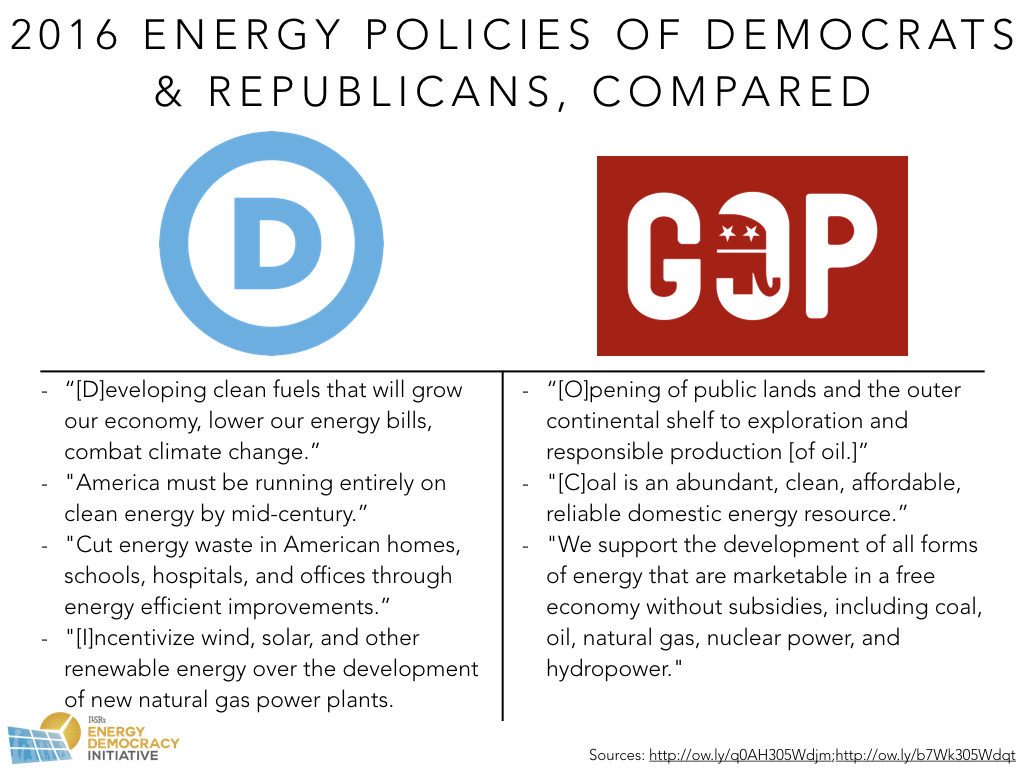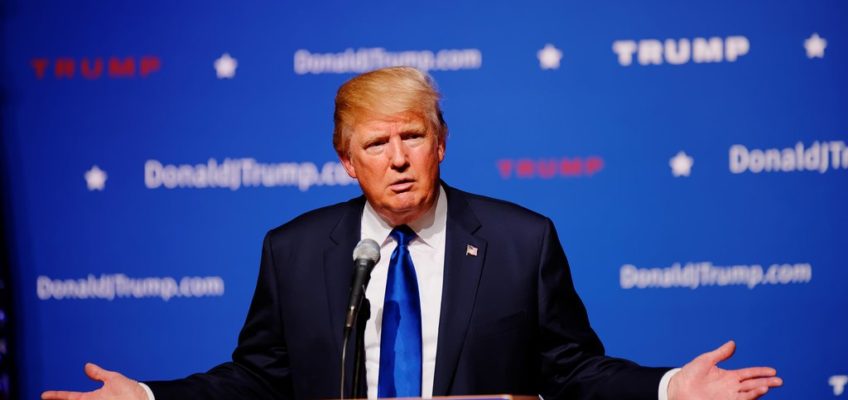The U.S. energy economy faces unprecedented pressure to integrate clean and renewable fuel sources like wind and solar, but after a distracting 2016 presidential campaign sidelined energy policy, troubling and untenable gaps in the president-elect’s strategy remain unchecked.
In the run-up to Tuesday’s election, the lone flicker of interest in clean energy was promptly extinguished when Ken Bone, who raised the issue during the Oct. 9 town hall-style debate, became an Internet sensation known more for his red sweater than for probing the unknowns clouding the country’s energy future (we wrestled with the answers).
Even as the U.S. tiptoes away from coal and grapples with environmental concerns, reporters and debate moderators sidestepped energy plans. Not unexpectedly, each candidate’s vision generally tracked with their party’s overarching views. But Donald Trump, even as he sits poised to take over the presidency, has yet to offer a comprehensive agenda.
Broadly speaking, the Republican has pledged to revert the U.S. energy economy back to coal and lift regulations on oil and gas production, erasing efforts by the Obama administration to bolster clean energy sources. He would repeal federal spending on clean energy, including wind and solar power. And Trump has also famously (and egregiously) claimed that climate change is a “hoax,” diminishing a central political motivation for promoting clean energy.
Trump’s coal-centric vision veers sharply from Democrat Hillary Clinton’s proposed plan, which hinged on jump-starting the clean energy economy. The candidates shared a bit of common ground, though — through the campaign, neither addressed local ownership of energy, a touchstone in the push to expand renewable generation left in flux after Trump’s election.

Clinton’s high-level plan to phase out coal and boost the clean energy economy put broad contours around a future underpinned by renewable generation, following a trajectory supported by science and economics. The Democrat outlined a strategy to install half a billion solar panels within four years, and generate enough renewable energy to power every U.S. home within a decade.
Trump, meanwhile, has swatted down renewables, saying he would strip all funding for solar, wind, and efficiency. As revealed to date, his plan leaves little room for more distributed generation, like rooftop solar, and seems to ignore a growing appetite for community-scale energy development.
Early reports indicate that Trump’s key energy advisers will include at least one noted climate change skeptic, and others critical of the clean energy-oriented policies championed under the Obama administration.
Clinton’s plan left on the table pivotal questions about who will build and own expansive new power generation projects. But the Trump presidency comes with even more unknowns. Now, it’s unclear how the U.S. will mold its energy future and who will capture the benefits.
A Murky Outlook for Energy
The lack of clarity on central energy issues, like ownership, on both sides of the campaign illustrates the policy challenges that loom.
Clinton’s more robust plan was anchored by the transition to clean energy, a necessary step to promote energy independence for the U.S. and protect its environmental future. Investing in clean power offers energy savings and local economic stimulus if done right.
Still, while she called for expansive new clean power projects — specifically including wind, solar, hydro and geothermal generation — and promises to ease permitting for rooftop and community solar projects, Clinton also favored more expensive and less flexible nuclear power. She had promoted “consumer choice,” but her plan included the development of utility-scale plants and transmission lines, both potential competitors to distributed generation despite its huge market potential.
All this comes at a time when wind and solar installations are more affordable than ever, firing up campaigns nationwide to build locally owned generation projects. Those efforts frequently butt up against entrenched utilities unwilling to adjust their outdated profit models to better accommodate a grid that suits today’s energy needs. The Community Power Map, developed by the Institute for Local Self-Reliance and shown below, highlights these local efforts and the state policies that help or hinder them.
Cash-Flush Utilities Power
Utilities across the country logged tens of millions of dollars in campaign spending in the lead-up to Nov. 8. This election, they favored Clinton with more than $500,000 in campaign contributions, according to watchdog OpenSecrets — topping all other candidates for any office. Trump, meanwhile, didn’t crack the top 20.
There are several reasons why utilities might have looked to Clinton, including both her policies and widespread predictions she would prevail on Election Day. Importantly, UtilityDive notes, the power sector has historically supported candidates on both sides of the aisle who share its interests. And utilities’ political contributions have risen sharply in recent decades. Troublingly, they have funneled millions of dollars from customers into anti-consumer policy campaigns.
With utilities essentially serving as the gatekeepers to U.S. energy policy, the alliances they build with policymakers are key. Following their money exposes ties that could color the way the government treats the power sector — and the growing number of community-oriented proposals that counter utilities’ existing business strategies.
And utilities aren’t afraid to loosen their purse strings to maintain their influence.
As of early November, utilities had spent more than $25 million directly on a campaign to pass a constitutional amendment in Florida that would restrict homeowners’ access to benefits that make rooftop solar attractive and financially feasible. Cleverly masked as a consumer-friendly provision, the measure redoubles utilities’ assault on distributed solar in the Sunshine State.
Florida voters ultimately rejected the measure, but not before its advocates laid out a model for deceptive provisions designed to mislead the public. Proponents of the measure confirmed the strategy at a closed-door meeting, but a leaked audio recording caught one booster calling it “a little bit of political jiu-jitsu” designed to confuse customers by using language that seems to promote solar.
Though Florida has some of the country’s richest solar potential, investor-owned utilities have stymied solar growth in order to keep a tight grip on the marketplace.
Room for Federal Action
The U.S. has gone years without major federal energy legislation, except for extending tax credits for solar, wind, and other renewable energy technologies. The most recent federal budget extended the incentives for multiple years, with a plan to gradually phase them out.
With limited federal action, energy lobbying has shifted largely to the state level. State-by-state utility regulation virtually ensures individual states’ regimes will serve as primary battlegrounds in the fight for local control.
This year saw a historic number of state-level ballot initiatives aimed at influencing the energy landscape, often proposed when lawmakers do little on their own to promote locally owned wind and solar projects. Mostly backed by advocacy groups and legislators, citizen-sponsored proposals targeted various actions, from expanding energy choice to limiting nuclear generation.
The measures in most cases challenge a status quo that skews control toward investor-owned utilities that for generations have enjoyed monopoly status. The evolving energy marketplace both jeopardizes these utilities’ profits, historically driven by selling more electricity and upping their generation capacity, and spotlights their reluctance to adapt to shifting dynamics.
Fed up with a local utilities’ resistance to renewables, several Las Vegas casino operators opted to pay tens of millions in fees to exit the grid this year, allowing them to instead rely on solar power from other producers. MGM Resorts International, which over the summer unveiled a 26,000-panel rooftop solar project, alone agreed to shell out $86.9 million to make the move.
Going Forward, Who Wins?
Extreme divisions between utilities and residents, particularly problematic in Nevada and Florida, are stoking tensions nationwide. Widespread thirst for clean energy and local control, against the backdrop of hardline opposition from deep-pocketed monopoly utilities, emphasizes the need for more specific guidance on how to level competing interests in support of the public good.
There are several things a responsive president could do to support the development of renewable energy generation, generating benefits that can spread throughout the economy:
- Extend clean energy incentives, using cash rewards instead of the tax credits approved by the federal government to date. Delivering cash incentives for solar, wind, and other qualifying projects lowers the barrier to building them, ensuring that more market participants can play without relying on Wall Street partners to bankroll their work.
- Update PURPA, a federal law passed in 1978 to promote renewable energy generation, to factor in the cost of power delivery when determining avoided cost. Such a move would effectively reward qualifying projects built near substations for causing less strain to the grid, upping their value proposition.
- Impose a fee on fossil fuel users based on the amount of carbon and other pollutants they emit. The measure could be modeled after ones adopted in other countries, designed to steer companies and other power users toward renewable generation, or on domestic policies like Minnesota’s “value of solar”.
- Require all transmission projects under federal jurisdiction to undergo a competitive bidding process that includes non-wires alternatives, ensuring the chosen method is the best way to meet the need.
- Ask the Justice Department to study the implications of consolidation in the shrinking electricity industry. A wave of mergers and acquisitions in the power sector has limited competition, raising questions about the implications for consumers.
- Earmark Federal Highway Administration funds to support electric vehicle infrastructure development, continuing a push accelerated under the Obama administration.
Though Clinton’s energy strategy offered a few nuggets for distributed generation advocates — and certainly more than Trump’s plan — even she failed to demonstrate how her vision will disrupt a longstanding bias toward utility monopoly, despite her commitment to overhaul the U.S. energy mix.
Under a Trump administration, the prospects are exponentially shakier.
The question now is whether Trump will stick to his campaign pledge to move back in time on energy policy, in a move that almost certainly benefits incumbent utilities and fossil fuel companies or whether his mercurial temperament will leave an opening for communities to capture the wealth of their renewable energy resources.
Photo Credit: Michael Vadon via Flickr (2.0 CC)
This article originally posted at ilsr.org. For timely updates, follow Karlee Weinmann on Twitter or get the Energy Democracy weekly update.






